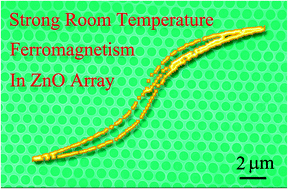Strong room-temperature ferromagnetism of pure ZnO nanostructure arrays via colloidal template
Abstract
Room temperature ferromagnetism in pure ZnO is a very interesting phenomenon, but the reported intensity is usually as weak as 10−2 to 10−3 emu g−1 and the mechanism is still in debate. Here, we report room-temperature ferromagnetism as strong as 6.1 emu g−1 from un-doped ZnO ordered arrays fabricated by a colloidal template method, and show a remarkable dependence of such ferromagnetism on grain size for the first time. Interestingly, the MS of samples could be tuned over a large scale, from 0.1 to 6.1 emu g−1 by adjusting the annealing time. Further study shows that grain size and oxygen are dominant factors for such magnetism. When the grain size, in vacuum, increases from 3 to 15 nm, the MS decreases from 5.7 to 0.25 emu g−1. For 3 nm grain size, ageing in the presence of oxygen, such as in air, for 1 week causes the MS to decrease to one-tenth of the original value. However, the MS of samples aged in vacuum does not change distinctly. Based on the observation and analysis of the above phenomena, we propose that oxygen vacancies at the surface of nanoparticles contribute to the ferromagnetism. This study could provide very simple and cheap semiconductor nanostructures with strong room temperature ferromagnetism for future spintronic applications and will deepen our understanding of the defect-related origin of such magnetism in ZnO.


 Please wait while we load your content...
Please wait while we load your content...